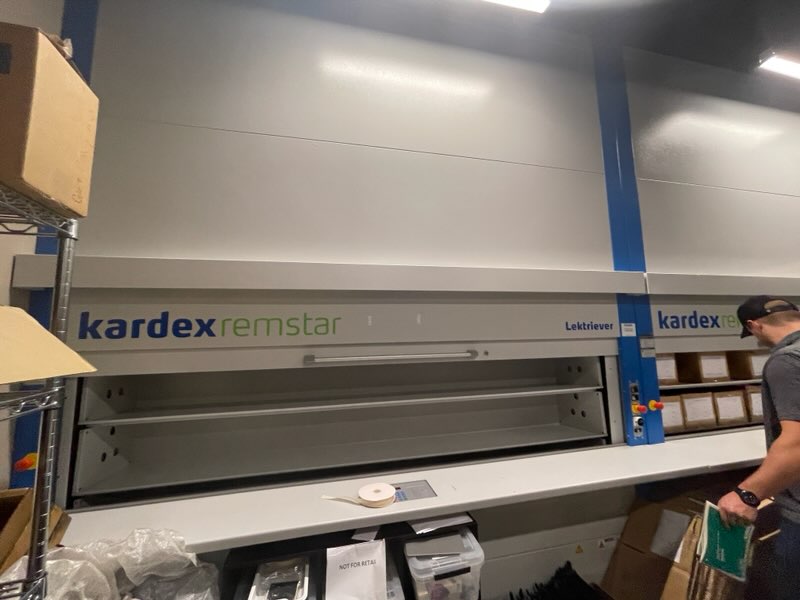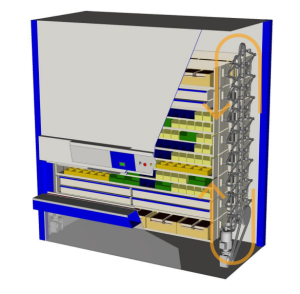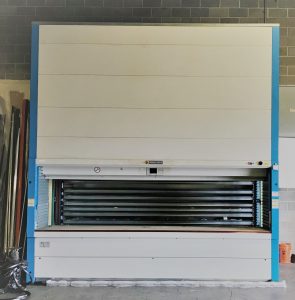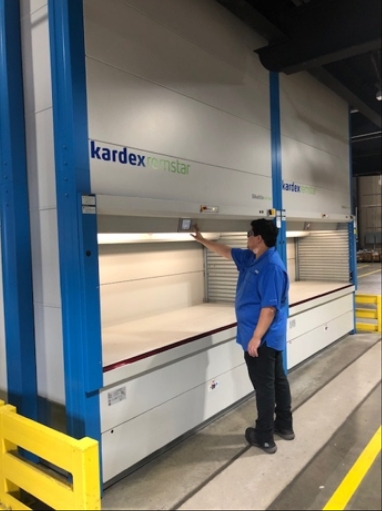What Is a Vertical Carousel?
A vertical carousel is an automated storage and retrieval system (AS/RS) that uses a series of carriers or shelves that rotate vertically (like a high-tech Ferris wheel) inside an enclosed cabinet. Instead of employees walking to find items, the vertical carousel brings the requested shelf directly to an ergonomic access opening at the push of a button or scan.
Vertical carousel storage systems are designed to:
Use vertical space instead of floor space
Keep inventory organized and secure inside an enclosed unit
Deliver items to the operator quickly and safely at waist height
At Vertical Storage USA, we design vertical carousel systems for warehouses that handle high SKU counts, small parts, or sensitive inventory where accuracy and space efficiency are critical.
Key Industries Benefiting from Vertical Carousels
If your warehouse is overflowing with inventory, and picking orders feels like an Olympic sport, you’re not alone. Businesses across various industries are turning to vertical carousels to bring order to the chaos. These automated storage systems help maximize space, improve efficiency, and make life easier for warehouse teams. But which industries benefit the most from this technology? Let’s dive into a few key ones that are seeing big wins with a vertical carousel.
Manufacturing: Keeping Production Lines Moving
In manufacturing, efficiency isn’t just a goal—it’s the difference between hitting deadlines and facing costly delays. If your facility handles thousands of small parts, bolts, or components, a vertical carousel can transform your storage game. Instead of workers hunting through bins and shelves, a carousel delivers the exact item at the push of a button.
Imagine how much smoother production runs when employees don’t have to leave their stations to retrieve essential parts. By reducing the time spent searching for inventory, manufacturers can boost productivity and minimize downtime. Plus, keeping everything organized means fewer misplaced items, which leads to fewer headaches.
Automotive: Managing a Mountain of Parts
The automotive industry is all about precision, and that extends to its warehouses. Whether it’s spare parts, tires, or specialty tools, every second spent looking for an item is time wasted. Vertical carousels help dealerships, repair centers, and automotive manufacturers keep track of their vast inventory without wasting valuable floor space.
Think about the number of different screws, filters, and electrical components needed for a single vehicle. Now multiply that by hundreds or even thousands. Without an efficient system, it’s a recipe for clutter and confusion. A vertical carousel stores parts compactly while offering quick retrieval, reducing worker fatigue and improving overall workflow.
Healthcare & Pharmaceuticals: Prioritizing Accuracy and Safety
In the healthcare and pharmaceutical industries, precision isn’t optional—it’s critical. Hospitals, pharmacies, and medical suppliers handle high-value items that often have strict storage requirements. Vertical carousels make it easier to organize medications, medical devices, and sterile equipment while ensuring compliance with safety regulations.
With automated storage, hospitals can quickly access surgical instruments, and pharmacies can reduce errors in medication dispensing. It also improves inventory control, making it easier to track expiration dates and reduce waste. When every second counts, having an organized system in place can make a significant difference in patient care.
Aerospace: Handling High-Value and Oversized Inventory
The aerospace industry deals with some of the most expensive and complex parts imaginable. From turbine blades to avionics components, everything needs to be stored securely and accessed efficiently. A vertical carousel provides a space-saving solution that protects delicate equipment while improving retrieval times.
With automated storage, aerospace manufacturers can streamline maintenance operations and avoid losing track of critical parts. It’s not just about saving space—it’s about ensuring that engineers and technicians have quick access to the tools they need to keep planes flying safely.
E-Commerce & Retail: Keeping Up with Customer Demands
If you run an e-commerce warehouse, you know that fast and accurate order fulfillment is the name of the game. Customers expect quick shipping, and that means your inventory storage needs to be as efficient as possible. Vertical carousels help businesses keep products organized, speed up picking, and reduce the chances of shipping errors.
Rather than having employees walk up and down aisles, a carousel brings the item directly to them. This not only improves productivity but also reduces strain on workers, creating a better work environment. Whether you’re handling clothing, electronics, or specialty products, automated storage helps meet the growing demands of online shopping.
How Do Vertical Carousel Storage Systems Improve Warehouse Efficiency?
Vertical carousel storage systems improve warehouse efficiency in several practical ways:
1. Maximize space utilization
Vertical carousels store inventory in a compact footprint while using the full height of the building. Many operations can recover 60–80% of floor space previously taken up by static shelving or bin racks. That freed-up space can be used for staging, packing, or additional inventory.
2. Reduce travel time and labor costs
Instead of walking aisles and hunting for parts, operators stay at a fixed access point while the carousel brings items to them. This “goods-to-person” model drastically cuts walking time, increases picks per hour, and often allows you to do the same volume with fewer labor hours.
3. Increase picking speed and throughput
Integrated controls, pick-to-light, and batching options help operators pick multiple orders at once with minimal motion. That combination of shorter travel, faster access, and guided picking translates into higher throughput without sacrificing accuracy.
4. Improve inventory accuracy and control
Each transaction—pick, put-away, or cycle count—can be recorded through software. This makes it easier to maintain accurate, real-time inventory, reduce lost or misplaced items, and support traceability for regulated industries.
5. Enhance ergonomics and safety
Items are presented at an ergonomic height, so employees aren’t climbing ladders, reaching, or lifting awkwardly. This reduces fatigue and the risk of injury, while the enclosed design keeps inventory protected and aisles clear.
When vertical carousels are integrated with warehouse management software, they become a powerful tool for improving warehouse efficiency end-to-end—from space utilization to labor productivity and accuracy.
Questions to Ask Before Investing in Automation
So, you’re thinking about upgrading your warehouse with automation? Smart move! But before you dive in, there are some key questions you should ask to make sure you’re making the right decision. Automation, whether it’s a vertical carousel or a full warehouse management system, can be a game-changer—but only if it aligns with your business needs. Let’s break it down and make sure you’re asking the right questions before making a big investment.
What Problem Am I Trying to Solve?
Before you start shopping for automation solutions, take a step back and pinpoint your biggest warehouse challenges. Is your team wasting too much time picking and retrieving inventory? Are you running out of space? Do you struggle with inventory accuracy?
A vertical carousel is great for saving space and improving retrieval speed, but if your problem is inefficient shipping processes, you may need something different. Clearly identifying your pain points will help you choose the right automation system instead of investing in technology just because it looks cool (even though it totally does).
How Will Automation Impact My Workforce?
It’s easy to get excited about automation, but have you considered how it will affect your employees? A common misconception is that automation replaces workers, but in reality, it helps them do their jobs more efficiently. With a vertical carousel, for example, employees don’t have to walk long distances or search through cluttered shelves to find what they need. That means fewer mistakes, less fatigue, and faster order fulfillment.
But there’s another side to this—your team may need training to use the new system. Will you need to hire someone with technical expertise? How long will it take for employees to get comfortable with automation? Answering these questions upfront will prevent headaches later on.
What Kind of ROI Can I Expect?
Let’s be honest: automation isn’t cheap. But the right system should pay for itself over time. The key is figuring out how long that will take and what kind of return on investment (ROI) you can expect. Will a vertical carousel help you reduce labor costs? Will it speed up order processing enough to increase customer satisfaction and boost revenue?
Take a look at your current operating costs—how much time and money are you losing due to inefficiencies? Then compare that to the cost of the automation system and potential savings. Many businesses see a positive ROI within a few years, but it’s important to run the numbers before making a commitment.
Is My Warehouse Ready for Automation?
Not every warehouse is designed to accommodate high-tech automation, so you’ll need to evaluate whether your facility is a good fit. Do you have enough ceiling height for a vertical carousel? Will you need to reconfigure your layout to make space for automated equipment? Do you have the right power supply and network connections?
Even if your warehouse needs some adjustments, don’t let that discourage you! Many automation solutions can be customized to fit different spaces, but knowing what changes might be required will help you plan ahead.
Will Automation Scale with My Business?
Your warehouse needs today might not be the same as your needs five years from now. If your business grows, will your automation system be able to grow with it? A vertical carousel is great because it can be expanded or integrated with other technologies like warehouse management systems (WMS).
Think about where your business is headed—if you expect to double your inventory in the next few years, investing in a scalable solution now can save you from having to make another big upgrade down the road.
What’s the Total Cost of Ownership?
The upfront cost of automation is just one part of the equation. You also need to consider ongoing expenses like maintenance, software updates, and potential repairs. How often will your system need servicing? Are there additional costs for training your team?
A vertical carousel, for example, has relatively low maintenance needs compared to more complex automated systems, but it’s still important to factor in long-term costs. Understanding the total cost of ownership helps you budget more effectively and ensures there are no surprises later.
Comparing Vertical Carousels with Horizontal Solutions
Both vertical and horizontal carousels are automated storage and retrieval systems (AS/RS) that move shelves or bins of products to a stationary operator, instead of forcing workers to walk to the product. They’re ideal for high-SKU environments, small parts, and operations that need faster picking and better space utilization.
While they share the same “goods-to-person” principle, they differ in footprint, motion, storage flexibility, and ideal use cases. Understanding these differences will help you decide which carousel storage system is the best fit for your warehouse.
Choosing the right automated storage solution for your warehouse is no small decision. Should you go with a vertical carousel or a horizontal carousel? Both offer incredible efficiency, space savings, and faster picking times, but the best choice depends on your space, inventory, and workflow. Let’s break it down in a way that actually makes sense—no boring tech talk, just real-world comparisons to help you decide which system is right for you.
How They Work: The Basics of Vertical vs. Horizontal Carousels
A vertical carousel looks a lot like a giant, high-tech Ferris wheel for inventory. It rotates carriers up and down inside a tall, enclosed cabinet and brings stored items directly to the operator at an ergonomic access point.
A horizontal carousel functions more like a racetrack. Instead of moving vertically, it rotates carriers side-to-side along an oval or rectangular track until the correct bin reaches the picker.
Before we dive into the pros and cons, let’s start with how these systems actually work. A vertical carousel looks a lot like a giant, high-tech Ferris wheel for inventory. It moves up and down, bringing stored items directly to the operator at an ergonomic retrieval point. This design is perfect for warehouses with limited floor space but plenty of vertical clearance.
On the other hand, a horizontal carousel functions more like a racetrack. Instead of going up, it moves inventory sideways along an oval or rectangular track, continuously cycling bins until the correct item reaches the picker. It’s a great choice for facilities that have more horizontal space to work with and need rapid order fulfillment.
Space Considerations: Which One Fits Your Warehouse Best?
One of the biggest deciding factors between vertical and horizontal storage solutions is your available space. If your warehouse is tight on floor space but has plenty of height to work with, a vertical carousel is the obvious winner. These machines take advantage of vertical real estate, storing items in a compact and efficient manner. Plus, they help clear up valuable floor space for other operations.
On the flip side, if you’re working with low ceilings and a wide-open layout, a horizontal carousel could be the better fit. Since it spreads storage across the floor rather than stacking it upwards, it’s ideal for warehouses with large, open areas but limited height.
Speed and Efficiency: Which One Works Faster?
Both systems are designed to improve picking speed, but they do it in slightly different ways. A vertical carousel brings the needed item directly to the operator at an ergonomic height, reducing travel time and eliminating unnecessary walking. This makes it a fantastic option for reducing worker fatigue and improving accuracy in picking.
Horizontal carousels, however, are often used in high-speed picking environments because they can be grouped in pods and used with batch-picking strategies. Multiple carousels can work together to fulfill multiple orders simultaneously, making them a powerhouse for rapid order fulfillment. If you’re dealing with a high volume of small, fast-moving items, a horizontal system might be the way to go.
Inventory Type: What Kind of Items Are You Storing?
Different inventory types call for different storage solutions. If you’re storing small to medium-sized items that need to be accessed quickly and frequently, a horizontal carousel is a great option. Think of high-demand parts, medical supplies, or e-commerce goods that need to be picked at lightning speed.
A vertical carousel, however, is better suited for items that need secure, well-organized storage. If you’re dealing with fragile parts, sensitive medical equipment, or inventory that requires better space optimization, a vertical system ensures your items stay safe and accessible.
Maintenance and Costs: Which One Is Easier to Manage?
Automation should make your life easier, not create extra maintenance headaches. Fortunately, both vertical and horizontal carousels have relatively low upkeep compared to traditional shelving. However, because a vertical carousel relies on a single motorized system to move inventory up and down, it often requires less maintenance than a horizontal carousel, which has longer tracks and multiple moving parts.
In terms of cost, horizontal carousels tend to have a lower upfront price, but if space is a concern, the savings from a vertical system’s footprint can quickly offset the initial investment. When considering cost, it’s important to factor in not just the purchase price but also long-term efficiency, labor savings, and how well the system aligns with your warehouse layout.
Conveyor vs. Carousel: What Should You Consider?
When choosing between a conveyor system and a carousel system, it helps to think about how you move product today and what problem you’re trying to solve.
1. Type of movement
Conveyors move cartons or totes from point A to point B (for example, from picking to packing or shipping).
Carousels (vertical or horizontal) are designed for storage and retrieval, bringing items from storage locations directly to an operator.
2. Space and layout
Conveyors require fixed paths on the floor (and possibly overhead), which can limit layout changes.
Vertical carousels use vertical space, while horizontal carousels use compact, pod-based footprints that can be rearranged more easily than long conveyor lines.
3. Throughput and order profile
If you need to move a high volume of cartons continuously between zones, a conveyor is often the right tool.
If your main bottleneck is finding and picking items quickly from storage, a carousel system will typically deliver more value.
4. Flexibility and scalability
Conveyors are great for stable, repeatable flows but can be harder to reconfigure.
Carousels are modular—you can add more units or integrate them with other automation (like Vertical Lift Modules or goods-to-person stations) as you grow.
5. Investment and ROI focus
Conveyor projects are typically about material flow between processes.
Carousel projects are about space savings, labor reduction in picking, and higher inventory accuracy.
At Vertical Storage USA, we often recommend starting with carousel storage when inventory access, space constraints, and picking labor are your biggest pain points—and layering in conveyors later once your storage operations are optimized.
Signs Your Warehouse Needs a Storage Upgrade
Is your warehouse feeling more like an obstacle course than a smooth-running operation? Are your employees constantly searching for inventory or squeezing through tight spaces just to pick an order? If so, it might be time for a storage upgrade. From cluttered aisles to slow fulfillment speeds, there are plenty of signs that your warehouse could benefit from better organization and automation. Let’s go through a few red flags that might indicate it’s time to rethink your storage strategy—whether that means installing a vertical carousel or making other smart upgrades.
Your Warehouse Feels Overcrowded (And Not in a Busy-but-Efficient Way)
If your warehouse is starting to feel like a game of Tetris—except you’re always one move away from disaster—you’ve got a storage problem. When inventory piles up, aisles become cramped, and employees have to weave through stacks of boxes just to do their jobs, it’s a clear sign that space optimization is overdue.
A vertical carousel can be a game-changer for space efficiency because it stores inventory in a compact, automated system that utilizes vertical space instead of taking up precious floor area. Instead of expanding your warehouse footprint (and your budget), smarter storage solutions can help you maximize the space you already have.
Order Fulfillment Is Slower Than It Should Be
If your team is spending more time searching for inventory than actually fulfilling orders, it’s time to rethink your storage layout. Slow picking times mean frustrated customers, overwhelmed employees, and a serious bottleneck in productivity. You shouldn’t have to send workers on a warehouse scavenger hunt just to complete an order.
Automated solutions like vertical carousels bring inventory directly to the operator, eliminating unnecessary walking and search time. When your most-picked items are easily accessible, employees can complete orders faster, improving efficiency and reducing mistakes.
Employees Are Constantly Complaining About Accessibility
If your workers are always bending, stretching, climbing, or digging through boxes just to retrieve inventory, your storage system isn’t working for them. Not only does this slow down productivity, but it also increases the risk of injuries, leading to potential downtime and costly workers’ compensation claims.
A vertical carousel is designed with ergonomics in mind, bringing items to a comfortable, waist-high level for easy retrieval. That means no more dangerous ladder-climbing or heavy lifting—just smooth, effortless access to inventory with the push of a button. When storage works for your employees instead of against them, your warehouse becomes a much safer and more efficient place to work.
Inventory Accuracy Is Becoming a Nightmare
Have you ever had an order delay because the system says an item is in stock, but no one can actually find it? If inventory discrepancies are becoming a regular issue, it’s a sign that your storage and tracking methods need an upgrade.
A vertical carousel can integrate with warehouse management systems (WMS) to track inventory levels in real-time, reducing the chances of misplaced or miscounted stock. With better organization and tracking, you’ll always know exactly what’s in your warehouse and where to find it—no more frustrating stock mismatches.
You’re Losing Money Due to Damaged or Expired Products
If damaged goods or expired inventory are eating into your profits, poor storage conditions might be to blame. Stacking inventory improperly, exposing it to dust and moisture, or forgetting about older stock can lead to costly losses.
A vertical carousel keeps items organized and protected from environmental hazards while ensuring that the right products are used first. With better inventory rotation and safer storage, you can reduce waste and keep your products in top condition for customers.
Scaling Your Business Feels Impossible with Your Current Storage
As your business grows, your warehouse needs to grow with it. If you’re constantly running out of space, struggling to meet demand, or hesitating to expand your inventory because you simply don’t have room, it’s time to upgrade.
A vertical carousel is a scalable solution that adapts to your changing needs. Whether you’re increasing stock levels, adding new product lines, or simply streamlining operations, better storage solutions can help you keep up with demand without constantly rearranging your warehouse.





